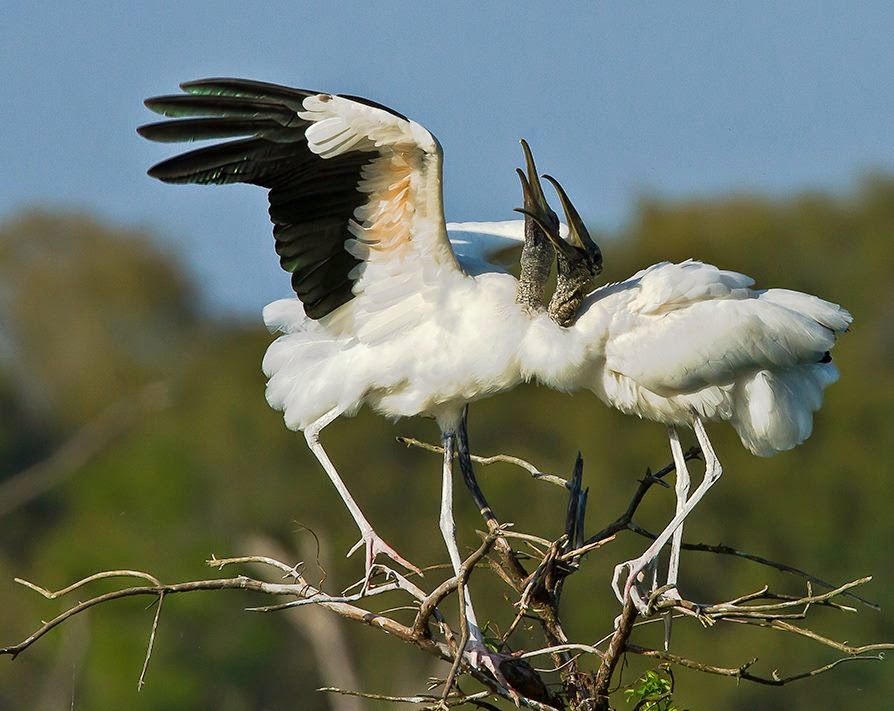 |
| Interior Secretary Sally Jewell |
Last week. Secretary of the Interior Sally Jewell announced
the official "downlisting" of the wood stork from endangered to threatened.
Personally I would have called the status change an upgrade, since that is
indeed what it is.
Sec. Jewell made the announcement at Georgia's Harris Neck
National Wildlife Refuge, which now hosts the largest single wood stork rookery in the
U.S., with about 400 breeding pairs. That's great news, of course. Even better
news is that this large colony represents only about 3.5 percent of all the
breeding pairs in Florida, Georgia and the Carolinas, according to last year's
census. This year's numbers are looking even better.
Consider that in 1978, there were just 2,695 nesting pairs,
all confined to Georgia and Florida, and these numbers are remarkable indeed. When
the wood stork officially made the endangered list in 1984, scientists were
seriously concerned that the bird could go extinct by 2000.
 |
| Wood stork happy dance |
The wood stork's decline was primarily due to destruction of
the birds' traditional nesting habitat in southern Florida. The construction of
canals, levees and floodgates in the Everglades effectively eliminated most of
the wetlands necessary to provide food for these large wading birds.
The Department of Interior officially credits determined
efforts on the part of federal, state and private parties to protect and
restore wetlands elsewhere in Florida, Georgia and the Carolinas. I believe
equal credit has to go to the wood storks themselves, which set out from their
destroyed homelands and found new places to perpetuate themselves, hundreds of
miles from south Florida.
 |
| Bald eagle, no longer endangered |
I don't mean to take anything away from the many people who
have worked to protect and restore wetlands and who came up with innovative
ways to ensure nesting success for the storks. We humans are quite as capable
of patting ourselves on the back for correcting our environmental mistakes as
we are for making those mistakes in the first place. The whole notion of
"wildlife management" strikes me as somewhat absurd, actually. The
best wildlife managers on the planet are and always have been wildlife
themselves.
Until the largely hairless bipedal mammalian Homo sapiens showed up on the third
planet from the sun a few hundred thousand years ago, wildlife populations
managed themselves quite nicely by behaving appropriately within their assigned
link of the food chain. Human intrusion into these food chains has invariably
had devastating consequences.
It has only been in the past 50 years that humans have begun
making real efforts to undo some of the
devastating changes they have inflicted and continue to inflict on the planet and its other inhabitants.
Rachel Carson's watershed book Silent
Spring was published in 1962 and awakened Americans to the damage the
pesticide DDT was causing to populations of eagles, ospreys, pelicans, falcons
and other birds.
 |
| Osprey, sitting pretty |
When I first moved to the South Carolina Lowcountry in 1972,
bald eagles and ospreys were rare enough that a sighting was worth a newspaper
story. Both birds, along with brown pelicans and the American alligator, were
among the first animals listed as endangered under the Endangered Species Act (ESA)
when it was finally enacted in1973. That law authorized federal agencies to
regulate activities that could cause further harm to species that were
literally in danger of going extinct in the foreseeable future.
(As an aside, it was Republican President Richard M. Nixon
who urged Congress to pass the ESA, declaring that existing laws to prevent
extinction were inadequate. Can you imagine any Republican saying such a thing
today?)
Critics of the ESA insist that the law is not effective
because very few species have been taken off the list once they get on it. But
bald eagles, ospreys, brown pelicans, American alligators and peregrine falcons
have all been removed from the list because they have recovered sufficiently
due to efforts supported by the ESA. Perhaps in a few years wood storks will
also come off the list entirely.
 |
| Brown pelican, populations soaring |
What may be more telling is that since the law went into
effect in 1973, 99 percent of the species that have been listed have not gone extinct in spite of the efforts
of powerful lobbies that fight tooth and nail to prevent application of the
law.
What I find interesting about the success stories is that
the solutions have been relatively simple. Do nothing (i.e., don't cut down
critical forest habitats, don't drain swamps, don't poison the planet, etc.) or
take positive actions to restore what we've already damaged (i.e., restore
wetlands, plant long term (not just harvestable) forests, find new and safe
ways to deal with pests, etc.). In other words, let the wildlife manage
themselves and give them enough space to do so.
 |
| There is hope for this wood stork youngster |
That has been the idea behind marine sanctuaries and marine
protected areas, for example. Some animals that were in serious danger of disappearing have
recovered nicely if left alone. In some cases, fish that were too rare to be
caught have become commercially viable again when sections of ocean have been
put off limits for a while.
The animals know what to do, and what they mostly need from
us is to be left alone. Give them back some living space, stop taking so much
of their living space (i.e. stop creating so many more humans) and they will
manage themselves and their populations as they did for millions of years,
without even thinking about it.
In other words, we don't need wildlife management. We need
people management.
